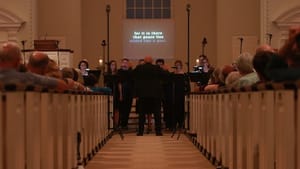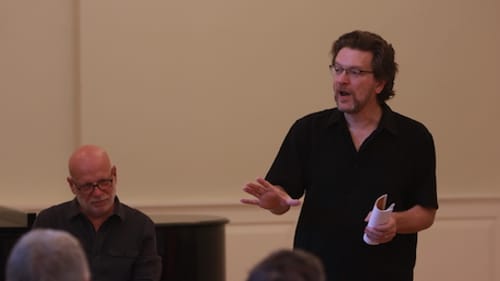Stay in the Loop
BSR publishes on a weekly schedule, with an email newsletter every Wednesday and Thursday morning. There’s no paywall, and subscribing is always free.
Reaching skyward
The Crossing presents Kile Smith's world premiere 'The Arc in the Sky'

On June 30, 2018, the Crossing closed its "Month of Moderns" at the Presbyterian Church of Chestnut Hill with the world premiere of The Arc in the Sky. This “pilgrimage for unaccompanied choir” by Philadelphia composer (and Broad Street Review contributor) Kile Smith was the evening’s sole work, set to texts by poet Robert Lax (1915-2000).
A mid-20th-century intellectual figure, Lax is not well known. A writer and minimalist poet, he greatly influenced philosopher Thomas Merton, a friend from their 1930s Columbia University student years. Both ultimately converted to Catholicism.
Merton’s spiritual journey led him to a Trappist monastery. After writing for publications including the New Yorker and Time, Lax chose a life of contemplation and poetics.
There are three sections in Smith’s 75-minute choral work: Jazz, Praise, and Arc. Each movement also has three sections.
Austere yet lush
Much of Lax’s work is austere and yet somehow lush in its imagery, attainable as written but challenging musically. The poet often puts just one or two words on a line, drawing you visually down the page.
Smith interprets this technique (called “concrete poetry”) and honors Lax’s rhythms by writing in an overarching rhythm of his own. Some movements are highly embellished tone poems, while others are transparent, quasi-religious and more musically spare. Thus, taken as a whole, Smith’s work speaks to the poet’s emotional dichotomy.
Jazz — the composition’s first section — opens with “why did they all shout.” In their youth, Lax and Merton frequented New York jazz clubs, and this movement contains the ecstatic energy and improvisatory syntax of hot jazz, with musical gestures that seem informal but are tightly constructed. The second movement, “there are not many songs,” is filled with haunting slow rhythms, augmented triads, rich chords, and ninths that quote jazz but never sound derivative.
“Cherubim & Palm Trees,” the work’s longest and most declamatory poem, is dedicated to Jean-Louis (Jack) Kerouac, a Lax admirer. A psalm-like setting, it features a quartet and ends with a joyful crescendo on “the courts of the house of God.”

A new sound
Smith uses the crescendo as a transition to Praise, his second section. This section opens with “I want to write a book of praise,” a meditation for male voices in unison that vacillates seductively between shape-note harmony and religious chant.
The Crossing’s bright sound is most often the sound of its women, so this setting was a welcome chance to hear the ensemble’s clear male voices. Smith followed with “The light of the afternoon is on the houses,” a sound painting for women’s voices (predictable but effective).
Praise closes with “Psalm,” a tonally dense work probing the complexities of faith and remembrance that ends with a triumphant major chord.
Here again, Smith presages and connects to the final section, Arc, which opens with “Jerusalem.” His repetition of “lovely ruined Jerusalem” moves melody and tempo forward in fits and parallels the poem’s uncertainty.

Following this long, dense text is “I would stand and watch them,” a luminous canonical section evoking the Sisyphean-yet-sacred nature of repetitive activity. Akin to the Shaker credo of work as prayer, this movement marks the work’s center and most strongly carries its message — melodically and textually. It weaves a thick aural tapestry that drops away to a single thread of sound, asking over and over (with a rising musical inflection), “why must you mend them?”
Catharsis
Smith’s final movement, “The Arc,” is an extended coda; “the arc in the sky, the arc of the sea” repeats like a mantra. Here, the pillars of sound were often overwhelming in the church’s acoustics. Clearly Smith (a previous Crossing collaborator) understands the ensemble’s sonority, but in this and several more convoluted, repetitive harmonic sections, the musical and textual impetus either overpowers or gets lost.
The work ends with triumphant chords, a release for both singers and audience. It must have been a huge challenge to create and present this work, and the audience responded ecstatically to both composer and choir.
“Ultimate tensile strength” is the maximum stress something can withstand while being stretched or pulled, and here the Crossing certainly displayed it. The Arc in the Sky deeply explores the poet’s unadorned yet hedonistic writing with sections of translucent beauty. Singing the work takes stamina and commitment.
Right from the start, it was clear the choir had a great love and appetite for Smith’s composition and was ready to do whatever he asked of them. He asked a lot, and they complied perfectly and joyfully.
What, When, Where
The Arc in the Sky, by Kile Smith, conducted by Donald Nally. The Crossing. June 30, 2018, at the Presbyterian Church of Chestnut Hill, 8855 Germantown Avenue, Philadelphia. Crossingchoir.org.
Sign up for our newsletter
All of the week's new articles, all in one place. Sign up for the free weekly BSR newsletters, and don't miss a conversation.

 Gail Obenreder
Gail Obenreder